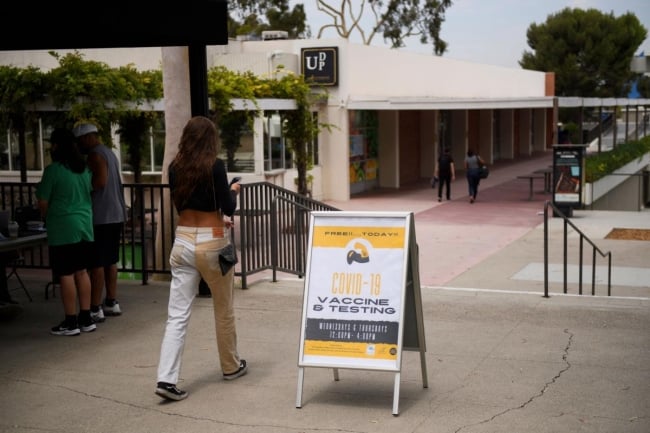You have /5 articles left.
Sign up for a free account or log in.

A COVID-19 vaccination clinic at California State University, Long Beach. A new report found that colleges’ vaccine policies and resources boosted students’ vaccination rates.
Patrick T. Fallon/AFP/Getty Images
A new survey conducted by the American College Health Association found that students were far more likely than the general adult population to get vaccinated against COVID-19: 82 percent of college students surveyed reported being fully vaccinated against COVID-19, compared with 65 percent of people aged 18 to 24 nationally, according to Centers for Disease Control and Prevention data.
The report, which looked at vaccination "uptake, attitudes, experiences, and intentions" among students, called campus vaccine requirements a “decisive factor” in their higher uptake rates. Forty-three percent of students said their college had a vaccine mandate in place; of those, 18 percent said they got vaccinated because their institution required it. The survey also found that 80 percent of students felt safer at institutions with those requirements.
“The role of college vaccination policies and communication was really profound,” said Dr. Sarah Van Orman, a co-author of the report and the former president of ACHA. “When we think about the uptake of vaccination among our college and university students compared to general young adults, we’re talking two to three times the level of vaccination, which really is a triumph of the public health infrastructure in our colleges and universities.”
The ACHA report comes as COVID cases are spiking on campuses with students returning for the fall semester, and as institutions begin to distribute new boosters for students ahead of a potential winter surge. Among students who reported receiving both of their initial vaccine doses but no booster, over half said they were unlikely to get further doses.
Dr. Van Orman said the report’s findings show that colleges and universities can play a crucial role in ensuring higher uptake rates among young adults for future immunization campaigns.
“We have a lot of students who got their primary series but maybe now are saying, ’Well, I don’t think I need the booster.’ That is a pretty large group right now,” said Dr. Van Orman, who is also the chief health officer for student affairs at the University of Southern California. “That’s another highlight of the report: a callout for universities to re-engage folks about why they need to stay up-to-date on their COVID-19 vaccines.”
Perhaps unsurprisingly, the survey also found that attitudes toward vaccination among students varied significantly depending on geography and political ideology. Ninety-six percent of students attending college in the Northeast reported receiving at least one vaccine dose, compared with 80 percent of students in the South. A similar breakdown emerged along political lines: 95 percent of college students who identify as liberal reported being vaccinated, compared to 70 percent of those who identify as conservative.
“Institutions of higher ed should have the best scientific information, and we can be leaders in our community,” Dr. Van Orman said. “This highlights that we need to continue to leverage our positions and engage with our communities to get the information out about vaccinations.”
Researchers surveyed 948 full- or part-time graduate and undergraduate students enrolled in in-person instruction at a two- or four-year institution in spring or fall 2022.
Two-year institutions lagged behind traditional four-year colleges in terms of the effectiveness of their vaccination policies and the strength of their messaging, according to the survey. Only 75 percent of two-year college students are vaccinated, compared with 87 percent of four-year undergraduates and 93 percent of graduate students. In addition, only 32 percent of two-year students said their institution required vaccines, and 60 percent said they were encouraged by their institutions to get vaccinated. Among undergraduates at four-year institutions, those numbers were 53 percent and 80 percent, respectively.
Dr. Van Orman said part of the reason for this discrepancy is that two-year institutions often don’t have the same resources or health services infrastructures as their four-year counterparts. That problem is not exclusive to two-year institutions: a quarter of students surveyed said their campus lacks a regular place where they go for health-care services. Among those who said they have such a place, only one in 10 reported it to be a student health center.
“One of the things we’ve seen emerging from the pandemic is that campuses need a health infrastructure to deal with communicable diseases, but also to advance the health of their students,” Dr. Van Orman said. “Most two-year institutions don’t have a student health center; they don’t have health communicators—they may not just have the resources to have all those things.”
Dr. Van Orman added that two-year colleges and other institutions serving marginalized populations have a unique opportunity to amplify their impact not only on students’ attitudes toward COVID vaccines, but also on their host community’s vaccination rates.
“When that two-year student is able to get good health information from their university and increase their vaccine confidence and get vaccinated, that might mean their grandmother gets vaccinated, their mother gets vaccinated, their child gets vaccinated,” she said. “Those institutions have the potential to have a really synergistic effect on the health of their community.”





